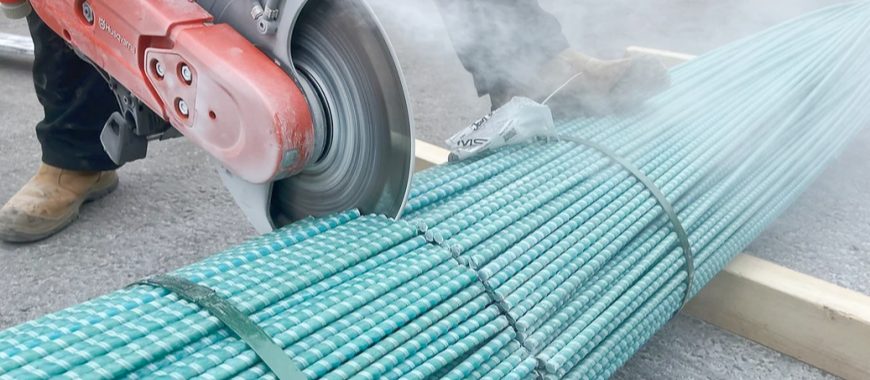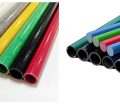
What is fiberglass rebar made of is an important consideration, as this innovative material offers significant advantages in various construction applications, particularly in environments prone to rust and degradation. Fiberglass rebar is a composite material made from glass fibers embedded in a polymer matrix, designed to provide a lightweight and corrosion-resistant alternative to traditional steel reinforcement. Understanding fiberglass rebar specifications is crucial for engineers and builders to ensure proper selection and application. Fiberglass rebar specifications: >70% fiber content, >22,000 psi shear strength, 600–1200 MPa tensile in cut lengths & bent shapes. Specifications of fiberglass rebar detail essential properties such as tensile strength, elasticity, and dimensions, which influence the performance and durability of the rebar in structural elements. By adhering to these specifications, construction professionals can leverage fiberglass rebar’s unique benefits, optimizing their projects for longevity and sustainability.
Fiberglass Rebar Specifications GFRP Rebar
GFRP (Glass Fiber Reinforced Polymer) rebar is engineered to meet specific fiberglass rebar specifications, making it an ideal choice for a variety of construction applications. The fiberglass rebar design plays a key role in optimizing its mechanical properties, such as high tensile strength and a favorable modulus of elasticity. The tensile strength of GFRP rebar typically ranges from 60,000 to 100,000 psi, providing significant resistance to breaking under load. Its modulus of elasticity can vary, commonly falling between 30 GPa to 45 GPa, depending on the formulation and manufacturing processes. This design not only ensures structural integrity but also enhances the material’s durability in harsh environments, including those exposed to corrosive elements. Fiberglass rebar case studies have shown that these properties are particularly beneficial in projects subject to heavy corrosion, providing long-term performance with reduced maintenance needs.
In terms of dimensions, fiberglass rebar is available in various sizes to suit different project needs. Common diameters range from 3/8 inch to 1-1/2 inches, allowing for versatility in reinforcing concrete structures. Additionally, GFRP rebar can be produced in custom lengths, often exceeding standard sizes, which makes it suitable for large-scale projects. Choosing fiberglass instead of rebar in construction provides a corrosion-resistant and lightweight alternative, making it easier to handle while maintaining structural integrity. Understanding these fiberglass rebar specifications is essential for engineers and architects to effectively integrate GFRP rebar into their designs, ensuring optimal performance and longevity in structural applications.
Cement Rods Fiberglass for Durable Construction Solutions
What are fiberglass rebar specifications and Fiberglass Rebar vs Steel Comparison
When comparing fiberglass rebar specifications to traditional steel rebar, it becomes evident that each material has its unique strengths and weaknesses, making them suitable for different applications. Below is a comparison table highlighting key specifications:
| Property | Fiberglass Rebar | Steel Rebar |
|---|---|---|
| Weight | Approximately 75% lighter | Heavier and more cumbersome |
| Corrosion Resistance | Highly resistant to corrosion | Prone to rust and degradation |
| Tensile Strength | 60,000 - 100,000 psi | Typically around 60,000 psi |
| Modulus of Elasticity | 30 - 45 GPa | 200 GPa |
| Durability | Lasts over 200 years | 50 years (with proper care) |
Advantages of Fiberglass Rebar:
- Corrosion Resistance: Ideal for environments exposed to chemicals and moisture, reducing maintenance costs.
- Lightweight: Easier to transport and handle on-site, which can lead to lower labor costs.
- Flexibility: Allows for custom shapes and sizes that traditional steel cannot easily accommodate.
Disadvantages of Fiberglass Rebar:
- Higher Initial Cost: Typically more expensive than steel, which may deter some projects.
- Brittleness: More prone to breakage under extreme stress compared to steel’s ductility.
- Limited Availability: Not as widely available as steel, which can lead to longer lead times for projects.
What are Fiberglass Rebar Specifications and Fiberglass Rebar Price?
When considering fiberglass rebar specifications, understanding the pricing factors is essential for budgeting a project. The price of fiberglass rebar can vary based on several factors, including the type, size, and market demand. Here’s an overview of the primary pricing factors:
- Material Quality: Higher quality fiberglass rebar with superior mechanical properties tends to cost more.
- Diameter and Length: Prices increase with larger diameters and longer lengths due to material usage.
- Brand Reputation: Well-established brands may charge a premium for their products based on reliability and performance history.
- Market Demand: Fluctuations in supply and demand can impact prices, particularly in construction booms.
Cost Comparison Table
| Material | Price per Unit | Notes |
|---|---|---|
| Fiberglass Rebar | $2.50 - $5.00 | Costs vary by size and quality |
| Steel Rebar | $0.80 - $1.50 | Generally less expensive but requires more maintenance |
Bulk Purchasing Options
Buying fiberglass rebar in bulk can significantly reduce overall costs. Many suppliers offer discounts for large orders, which can be beneficial for contractors working on extensive projects. The savings from bulk purchases can help offset the higher unit price of fiberglass compared to steel.
- Volume Discounts: Larger quantities often come with a lower price per unit, encouraging bulk buying.
- Reduced Shipping Costs: Purchasing in bulk can minimize shipping expenses, as fewer shipments may be needed for large projects.
What are Fiberglass Rebar Specifications and Fiberglass Rebar Stirrups
When discussing fiberglass rebar specifications, it’s essential to highlight the role and characteristics of fiberglass rebar stirrups. These stirrups are crucial in providing support and stability in various construction applications, especially in reinforced concrete structures.
Specifications of Fiberglass Rebar Stirrups
- Shapes: Fiberglass rebar stirrups are typically formed into U-shapes or rectangular configurations, allowing them to fit securely around vertical reinforcement bars.
- Sizes: They are available in multiple sizes to accommodate different construction requirements, with common diameters ranging from 3/8 inch to 1 inch.
- Uses: Stirrups are often employed in beams, columns, and slabs to hold longitudinal bars in place and provide lateral support.
Benefits of Using Stirrups Made from Fiberglass Rebar
- Corrosion Resistance: Unlike traditional steel stirrups, fiberglass rebar stirrups do not corrode, extending the life of concrete structures.
- Lightweight: Fiberglass stirrups are significantly lighter than their steel counterparts, making them easier to handle and install on-site.
- Increased Durability: These stirrups maintain their structural integrity even in harsh environmental conditions, such as high humidity or exposure to chemicals.
- Flexibility in Design: Fiberglass stirrups can be custom-manufactured to fit specific project needs, allowing for greater design versatility.
- Thermal Insulation: Being non-conductive, fiberglass helps maintain thermal insulation in construction, which can enhance energy efficiency.
Innovative Uses: Can You Reshape Fiberglass Rods Effectively
What are fiberglass rebar specifications and Disadvantages of Fiberglass Rebar
While fiberglass rebar offers numerous advantages, it is important to consider the fiberglass rebar specifications alongside its limitations. Understanding these disadvantages is crucial for making informed decisions in construction and engineering applications.
Limitations and Challenges of Fiberglass Rebar
- Cost: Fiberglass rebar is generally more expensive than traditional steel rebar. The initial investment may deter some projects, especially those with tight budgets.
- Brittleness: Fiberglass can be more brittle than steel, making it susceptible to cracking or breaking under certain stress conditions, particularly in extreme temperatures or during installation.
- Installation Expertise: Proper installation of fiberglass rebar requires skilled labor familiar with its properties. This need for specialized training can increase project costs and time.
- Compatibility with Concrete: Fiberglass rebar may have different bond characteristics with concrete compared to steel, which can affect the overall performance of the structure in some applications.
- Limited Availability: In some regions, fiberglass rebar may not be as readily available as steel, making sourcing a challenge and potentially delaying projects.
- Less Common Acceptance: Building codes and standards for fiberglass rebar are still evolving, and some jurisdictions may not fully accept its use in structural applications, limiting its applicability.
Fiberglass Rebar Manufacturing Process
The manufacturing process of fiberglass rebar is crucial for ensuring its strength, durability, and overall performance. Understanding fiberglass rebar specifications can provide insight into how these rods are produced and the key factors that influence their quality. By integrating powerful and durable fiberglass rebar into construction projects, manufacturers can ensure a reliable and long-lasting solution that meets the demands of various structural applications.
Overview of the Manufacturing Process
The production of fiberglass rebar involves several key steps, primarily focusing on the combination of high-strength glass fibers with a polymer resin matrix. This process ensures that the final product meets the necessary specifications for various construction applications.
- Key Materials Used:
- Glass Fibers: Continuous strands of glass fibers provide tensile strength and structural integrity. The quality of the fibers is critical, as higher glass content improves performance.
- Resin: A thermosetting resin, often vinylester or epoxy, binds the glass fibers together. The resin’s quality impacts the rebar’s resistance to environmental factors.
- Additives: Special additives may be included to enhance properties of fiberglass rebar such as corrosion resistance, UV stability, and fire retardance.
- Importance of Quality Control:
- Quality control measures are essential throughout the manufacturing process to ensure that the fiberglass rebar meets fiberglass rebar specifications. This includes testing for tensile strength, bonding characteristics, and moisture absorption.
- Regular inspections and testing at various production stages help identify any defects, ensuring that only the highest quality rebar is delivered to customers.
- Innovations in the Manufacturing Process:
- Recent advancements in the manufacturing process have introduced improved techniques, such as:
- Pultrusion: A continuous molding process that allows for precise control over the thickness and uniformity of the rebar.
- Advanced Resin Systems: The use of high-performance resins that improve the bond strength and durability of the rebar, making it more suitable for demanding applications.
- Automation: The integration of automated systems in production enhances consistency, reduces labor costs, and improves overall efficiency.
Cost Analysis: Investing in Galvanized Steel Bar Solutions
FAQs about Fiberglass Rebar Specifications
Yes, fiberglass rebar can meet building codes when manufactured according to established standards. In the United States, fiberglass rebar is often produced to comply with ASTM D7957 and other relevant specifications. These standards ensure that the rebar has the necessary mechanical properties, such as tensile strength and modulus of elasticity, to be used effectively in construction projects. It’s crucial to check that the fiberglass rebar you choose has proper certifications to ensure compliance with local and national building codes.
While fiberglass rebar offers many advantages, it also has some downsides.
Cost: It can be more expensive than traditional steel rebar, which may not be ideal for projects with tight budgets.
Brittleness: Fiberglass can be more brittle than steel, making it susceptible to breaking under high-stress conditions.
Limited Structural Use: In some applications, particularly those requiring heavy loads or high shear strength, fiberglass rebar may not perform as well as steel.
Installation Practices: Specialized knowledge and tools may be required for proper installation, which can increase labor costs.
Fiberglass rebar boasts several noteworthy properties that make it suitable for various applications:
Corrosion Resistance: Unlike steel, fiberglass rebar does not corrode, making it ideal for environments exposed to moisture or chemicals.
Lightweight: It is significantly lighter than steel, facilitating easier handling and transportation.
High Tensile Strength: Fiberglass rebar typically has a tensile strength greater than that of traditional steel, enhancing its performance in tension.
Electromagnetic Neutrality: It does not conduct electricity, which is beneficial in specific applications, such as in areas sensitive to electromagnetic interference.
The effectiveness of fiberglass rebar compared to steel rebar depends on the specific application and environmental conditions.
Strength: While fiberglass rebar has high tensile strength, it may not provide the same shear strength as steel in certain structural applications.
Durability: Fiberglass rebar is more durable in corrosive environments, whereas steel can rust and weaken over time.
Cost: Steel rebar is generally more affordable and widely available, making it the preferred choice for many construction projects.
Ultimately, the choice between fiberglass and steel rebar should be based on project requirements, budget, and environmental considerations.

As the editor of GangLong Fiberglass, I have years of experience and in-depth research, focusing on cable tray products, fiberglass solutions, and grille systems. I incorporate years of industry insights and practical experience into every content, committed to promoting the progress of the industry. At GangLong Fiberglass, my commitment is reflected in every product, from innovative cable trays to durable fiberglass solutions and sturdy grille systems. As an authoritative voice in the industry, my goal is to provide valuable information to professionals and businesses and promote forward-looking solutions.


